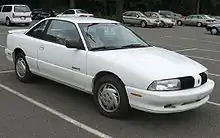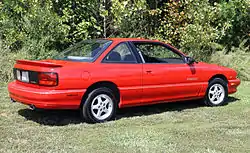Oldsmobile Achieva
The Oldsmobile Achieva is a front-wheel drive compact sedan and coupe that was introduced by Oldsmobile for the 1992 model year.[1] The Achieva was based on the GM N-body platform, which it also shared with its siblings the Pontiac Grand Am and Buick Skylark. The Achieva replaced the GM N-body Cutlass Calais after its final 1991 model year, and ended production after the 1998 model year.
| Oldsmobile Achieva | |
|---|---|
 | |
| Overview | |
| Manufacturer | General Motors |
| Production | 1991–1997 |
| Model years | 1992–1998 |
| Assembly | Lansing, Michigan, United States |
| Body and chassis | |
| Class | Compact car |
| Body style | 2-door coupe 4-door sedan |
| Layout | Transverse front-engine, front-wheel drive |
| Platform | GM N platform |
| Related | Buick Skylark Pontiac Grand Am Chevrolet Corsica Chevrolet Beretta |
| Powertrain | |
| Engine | 2.3 L Quad 4 I4 2.4 L LD9 I4 3.1 L L82 V6 3.3 L LG7 V6 |
| Transmission | 3-speed 3T40 automatic 4-speed 4T60-E automatic 5-speed Getrag 282 manual |
| Dimensions | |
| Wheelbase | 103.4 in (2,626 mm) |
| Length | 1992–95: 187.9 in (4,773 mm) 1996–98: 187.8 in (4,770 mm) |
| Width | 1992–93: 67.5 in (1,714 mm) 1994–98: 68.6 in (1,742 mm) 1996–98 Sedan: 68.1 in (1,730 mm) |
| Height | 1992–93: 53.2 in (1,351 mm) 1994–98: 53.5 in (1,359 mm) |
| Chronology | |
| Predecessor | Oldsmobile Cutlass Calais |
| Successor | Oldsmobile Alero |
Overview
The Achieva was a compact car produced by the General Motors' Oldsmobile division from 1991 to 1998 and was available as a sedan or coupe. It was offered in four different trim levels during its production run: S, SC, SL, and SCX. Available engines included different versions of the Oldsmobile-developed 2.3 L Quad 4: the base single-cam L40 "Quad OHC", the DOHC LD2, the high-output LG0, and the special "W41" variant of the LG0 Quad 4 used in the SCX model. All were replaced for 1996 by a revised 2.4 L version. A pair of V6 engines were also offered including the Buick-sourced 90° 3.3 L "3300" V6, which was later replaced by Chevrolet's 60° 3.1 L "3100" V6. While a five-speed manual transaxle was initially offered as the standard base transmission, most Achieva models were sold with three-speed or four-speed automatic transaxles. The Achieva was last sold as model year 1998, after which it was replaced in the Oldsmobile lineup by the Alero for the 1999 model year.
Initial production

The Achieva was first seen as a concept car at the 1991 Chicago Auto Show, positioned to replace Oldsmobile's compact Calais models. The Calais and Achieva share the same front wheel drive N-body architecture including identical wheelbase. The Achieva started regular production for the 1992 model year. It was offered in four different trim levels: S and SL, available on both coupes and sedans, and the sporty SC and SCX coupes. The base S offered a 120 hp (89 kW) 2.3 L "Quad OHC" 4-cylinder, while the SL had the DOHC 160 horsepower (120 kW) Quad 4 engine standard that was optional on the S model. A 160 hp (120 kW) 3.3 L V6 engine was optional for the SL. The SC coupe had a standard 180 hp (130 kW) high-output Quad 4 with 5-speed manual transmission or a 3 speed automatic, with the 3.3 L V6 being an option.
SCX
The W41 coupe was introduced by Oldsmobile in 1991 on the Cutlass Calais and offered through 1993 on the Achieva. The Achieva SCX replaced the previous Cutlass Calais 442 W41 as the best handling, highest power output compact car in the Oldsmobile's lineup as well as being the last performance "W-Machine" Oldsmobile would offer. The SCX is a higher-performance version of the SC (sports coupe) and as such utilized the SC's deeper front bumper cover with standard fog lamps, lower body side cladding, rear bumper cover with dual exhaust tip cut-outs, as well as a unique W41-specific silver colored stripe around the lower body moldings, "W41" decals on the front fenders, and "Achieva SCX" decals at the leading edges of the doors. Other appearance changes for the SCX W41 package included the addition of a 140 mph speedometer in place of the standard 120 mph unit as well as a tachometer indicating the higher 7200 rpm red line.

Performance modifications primarily differentiated the SCX from the SC models and were designed to make the SCX competitive for use in showroom stock racing series such as the IMSA Firehawk and SCCA GRAND-AM World Challenge. This included the move to smaller diameter yet wider V-rated P215/60VR14 BF Goodrich Comp T/A tires on 14x6.5 inch cast aluminum wheels (compared to the SC's 205/55R16 on 16x6 inch wheels) and different suspension components on the SCX-specific FX3 RPO coded suspension. The suspension changes included larger diameter direct-acting front sway bar over the base Achieva, a wider rear axle with dual rear sway bars, "Computer Command Ride" (CCR) electronically adjustable struts and shock absorbers, as well as higher spring rates and bushing changes. (A similar CCR electronic suspension was also offered as an option on the Achieva SC as well as the platform-mate Buick Skylark and works similar to the systems offered on Cadillac and Corvette models of the time.)
The SCX's powertrain included the highest output naturally aspirated four-cylinder engine GM had produced up to that time: the 190 horsepower, 160 lb·ft W41 version of Oldsmobile's Quad 4 engine. Compared to the SC's standard high-output, 180 horsepower LGO Quad 4, the W41 version of the LGO Quad 4 was fitted with different camshafts, a low restriction exhaust system with dual mufflers and a special engine computer calibration for the ignition and fuel systems that also raised the engine's redline to 7200 rpm. This engine was complemented by a unique version of the Getrag-licensed, GM-Muncie built Getrag 282 five-speed transmission with special second and fifth gears as well as a different final drive ratio for quicker acceleration and better gearing to keep the engine in its power band.
The production numbers for the Achieva SCX in 1992 totaled 1146 cars made with (6) C41 RPO code A/C-delete racing models as follows: (1) bright red, (2) medium garnet red, (1) aqua, (1) blue, and (1) white cars. The normal C60 RPO code models included (472) bright red, (42) medium garnet red, (218) black, (196) aqua, (50) neon blue, (151) white, and (11) gray cars.
The 1993 SCX production totaled 500 cars produced including (5) C41 RPO code A/C-delete racing models as follows: (1) bright red, (1) aqua, and (3) white cars. The normal C60 RPO code models included (128) black, (191) bright red, (20) medium garnet red, (73) aqua, (8) neon blue, (70) white, and (5) majestic pearl cars.
Production changes
For the second year of production, all 1993 Achieva models saw a reduction in power across the engine lineup due to changes made to comply with stricter emission requirements. This resulted in all engine outputs being 5 horsepower (3.7 kW) lower for 1993, including the SCX which was down to 185 hp for its final year (primarily due to exhaust port changes to the cylinder head). Other changes for 1993 included a revised front engine mount and changes to the Quad 4 block casting to address criticism for that engine's NVH characteristics. For 1994, a driver-side airbag was added as a standard feature,[2] and the Buick-developed 3.3 L "3300" V6 was replaced by a Chevrolet-designed 3.1 L "3100" V6.
In 1995, trim levels were reduced to one: SC coupe and SL sedan, divided into two groups, Series I and Series II according to equipment. The Quad 4 with 150 horsepower (110 kW) and 3.1 liter V6 with 155 horsepower (116 kW) were the only available engines for 1995; the other two engines from the previous year were dropped.
The 1996 models added more standard features, include standard air conditioning and daytime running lamps, and a new dashboard featuring revised gauges and a passenger-side airbag. A Series III equipment level was added while the Series I was now only available on the coupe. The new base engine was a 2.4 liter four-cylinder "Twin Cam" that replaced the 2.3 L Quad 4. There were little changes other than reduced trim levels and options for the final two model years.
The final model year for the Achieva was 1998, with the majority of sales going to fleet customers. The Achieva was complemented at the end of its production run by the slightly larger Cutlass which overlapped Achieva production from 1997 to 1999. Both models were replaced in the Oldsmobile lineup by the Alero for 1999. The Cutlass and Alero were built on a redesigned GMX130 N-body platform that shared little chassis and platform architecture with the Achieva.
Achieva production ended on December 4, 1997.
Trim levels and engines
Trim levels
4-Door Sedan (1992–1998):
- S - 1992–1995
- SL - 1992-1998
2-Door Coupe (1992–1997):
- S - 1992–1995
- SC - 1992–1997
- SCX - 1992–1993
Engines
- 1992–1994 Quad OHC L40 2.3 L (140 cu in) I4, 115 hp (86 kW) and 140 lb⋅ft (190 N⋅m)
- 1992–1995 Quad-4 LD2 2.3 L (140 cu in) I4, 155-180 hp and 150 lb⋅ft (200 N⋅m)
- 1992–1994 Quad-4 LG0 2.3 L (140 cu in) I4, 175-180 hp and 160 lb⋅ft (220 N⋅m)
- 1992–1993 Quad-4 2.3 L (140 cu in) I4, 185-190 hp and 160 lb·ft (SCX W41)
- 1992–1993 3300 3.3 L (204 cu in) V6, 160 hp (120 kW) and 185 lb⋅ft (251 N⋅m)
- 1994–1998 3100 3.1 L (191 cu in) V6 160 hp (120 kW) and 185 lb⋅ft (251 N⋅m)
- 1996–1998 LD9 2.4 L (146 cu in) "Twin Cam" I4, 150 hp (110 kW) and 150 lb⋅ft (200 N⋅m)
Motorsport
The Achieva won the touring car championship of the SCCA World Challenge from 1992-1994. As of 2020, Oldsmobile is the only GM division other than Chevy (Sonic) to accomplish this feat and only one of two American brands (along with Chrysler's Eagle Talon '89-'91) to accomplish it in the 1990s. The Dodge Shelby Charger won the predecessor SCCA / Escort Endurance Championship in 1986.
References
- "1997 Oldsmobile Achieva Detailed Pricing and Specifications". Autos.msn.com. 2010-02-22. Archived from the original on 2011-09-27. Retrieved 2010-12-27.
- Bartlett, Jeff (September 2, 1995). "Long-Term Wrap Up: 1994 Oldsmobile Achieva". Motor Trend. Retrieved August 12, 2019.
| Wikimedia Commons has media related to Oldsmobile Achieva. |
